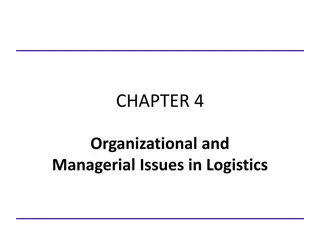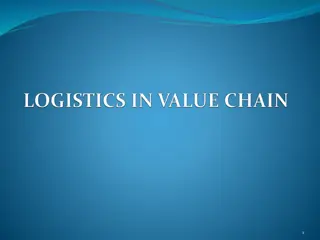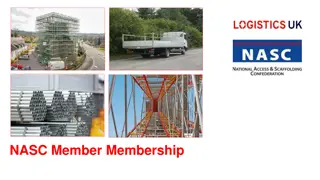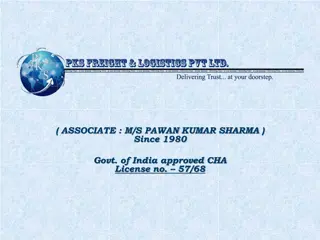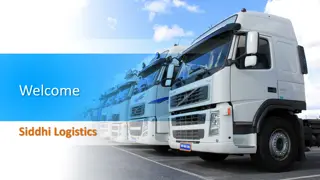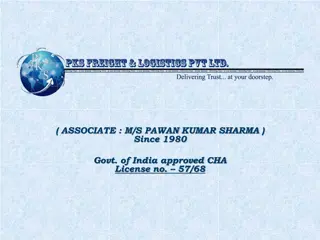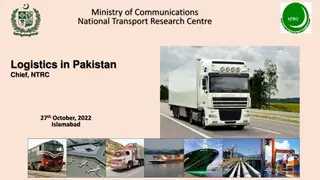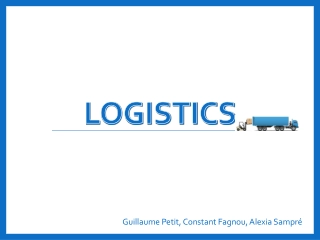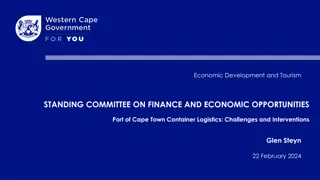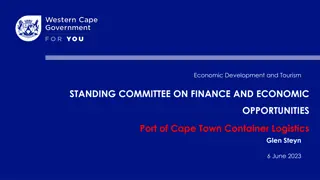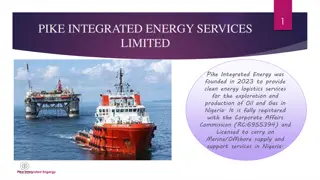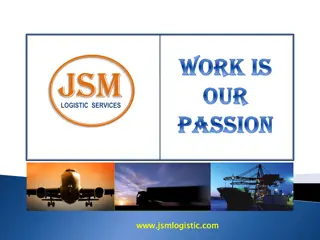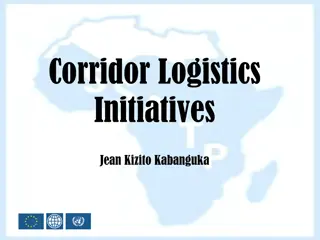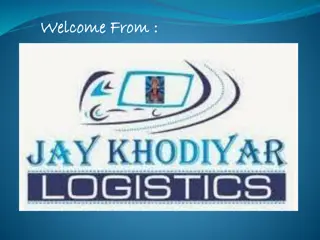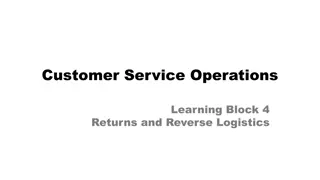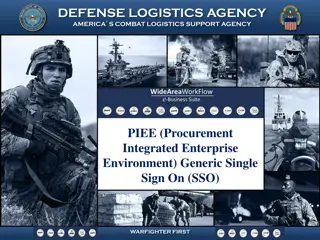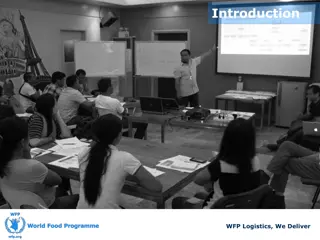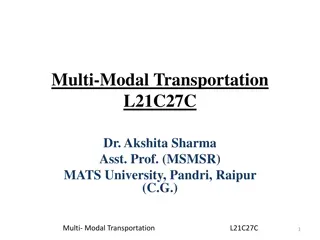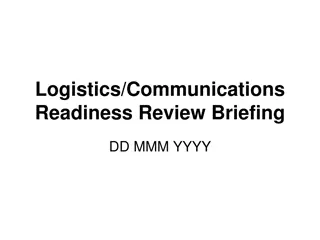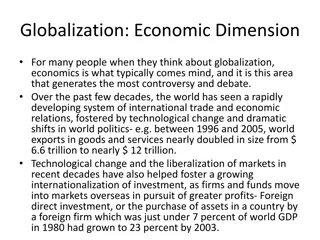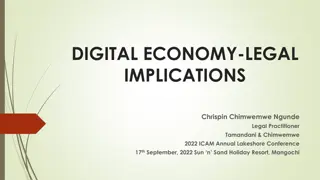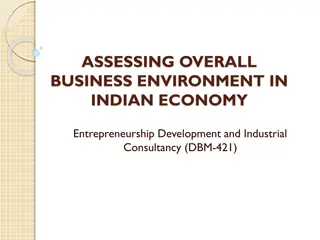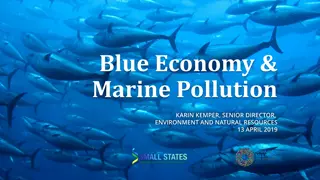Evolution of Logistics in the Globalized Economy
The logistics sector is undergoing significant changes in the era of globalization, with a shift from traditional transport-focused operations to integrated supply chain management. Globalization has reduced trade costs, leading to increased economic activity and the need for seamless collaboration among stakeholders. The key growth drivers in logistics include foreign trade, outsourcing of manufacturing, and the rise of organized retail. Warehousing now plays a crucial role in efficient inventory management and value-added services.
Download Presentation

Please find below an Image/Link to download the presentation.
The content on the website is provided AS IS for your information and personal use only. It may not be sold, licensed, or shared on other websites without obtaining consent from the author. Download presentation by click this link. If you encounter any issues during the download, it is possible that the publisher has removed the file from their server.
E N D
Presentation Transcript
National Academy of Indian Railways Regional Cooperation Programme 19thTraining Programme Integrated Transport and Logistics Logistics Parks and Terminals and Dry Ports-role of Integrated Multimodal Transport R Dayal Asian Institute of Transport Development Vadodara 9 March, 2016
Globalisation impacts logistics sector as no other branch of industry Logistics promotesand facilitates the processof globalisation. Logisticsshifts froma purelycostcentre tocentrecreating value. Effective logistics management helps companies gain competitive advantage throughvalueenhancementand cost reduction. Trade is becoming moreand moreglobalised, implying spatial expansion of theeconomy, morecomplex global economic integration, and an intricate network of global flowsand hubs. To stay competitive in complex business, all stakeholders must collaborate seamlessly across time horizons and functional and geographical barriers.
Globalisation... Theglobalization juggernauton an inexorable march. There is easy movement of goods, people, information, and finance across national frontiers. Globalization in this context is euphemism for falling transportand tradecosts. Freightcosts haveabout halved in real terms since the mid-1970s, driven by investments in transport infrastructure, bettercapacity use, and technological progress. Falling costs of transportation and communication shave made theworld smaller. But they havealso madeeconomicactivity moregeographicallyconcentrated. More trade means lower costs of transportation which, in turn, has meant more trade. Emphasis is on integration of national and international production systems with agreaterdemand of acommon webof integrated supplychain for speed, efficiencyand reliability.
Logistics assuming importance Logistics business is no longer limited to basic transportation. It encompasses a gamut of services suchas Warehousing distribution packaging labelling inventory management orderprocessing. Not only suppliers and customers are participants in the distribution or marketing channel, but also third party logistics providers (3PL). A 4PL or lead logistics manager is sometimes seen as a supply chain manager , a coordinating intermediary between the shipperand 3PL.
Evolution of logistics Keygrowth drivers The key growth drivers for the logistics sector such as increase in foreign trade, outsourcing of manufacturing activities and emergence of organised retail catalysing the growth of warehousing, supply chain management, cold storage and transportation. The changing business dynamics and the entry of global third-party logistics players (3PL) has led to the remodelling of logistics services in India. Rapid growth of warehousing The role of a warehouse has transformed from a conventional storehouse to an inventory managementset-upwith greateremphasis onvalue-added services. Today, there is an increasing trend of relocating warehouses near consumer markets. Traditionally, warehousing as an important constituent of the logistics sector has been dominated by small players with low capacities and poor handling, stacking and monitoring technologies. India's archaic warehousing system has been detrimental to efficient logistics output.
Transport...an evolving role More than half of world trade today is intra-industry trade. This trade consists of final and intermediate goods; both increased considerably over the last 50 years. Intra-industry trade in machines and transport equipment is the highest. Falling communications costs have resulted in greater fragmentation of services into components, supplied to final consumers from different parts of the world. Improvements in transportation and communications favour a process of geographical specialization that increases productivity and spatial interactions. Transport is not merely a cost centre as it has hitherto been considered. Transport is fast becoming a high-technology industry, making research and innovation crucial to its furtherdevelopment.
Transport now an integral part of production process. Transport has emerged to be a strategicsector. As trade becomes more and more globalised, logistics chains become morecomplex and need to be managed globally. It is now the integrated transportationchain that matters: production, transportation, storage, distribution, information all integrated into one unique network.
Integrating multimodal logistics the evolution of integrated multimodal logistics. Intermodal transport industry continues to evolve, and in so doing, it becomes increasingly integrated with supplychain management. Today, ocean carriers integrate into ports, inland terminals and landside transport links as well. Multimodal operators integrate into the reverseof this chain. Railwayscombine with port terminals. Road operators become logistics service providers. Freight forwardersextend traditional service boundaries. Thesedevelopments have significant implications for logistics players: transportation companies will continue to migrate from pure transport to value-added logistics services; boundaries between segments are likely toget blurred; consolidation trend will continue to increase, for scaleand capability.
Logistics parks A logistics park is ideally situated near a large industrial city/town for finished products from industries located nearby to be transported to distributioncentres speedily and economically. Similarly, raw materials can also be brought in conveniently through the park atcheapest cost. If area and character of the logistics park warrants, it may be designated as free trade warehousing zone and all facilities of a dry port made available. A logistics park should better be developed as a well-run business centre, to meet varying needs of trade and offering a vast range of services. It should include facilities for business and entertainment, banking, security, health, recreation, travel and transport, etc. - also for customs, shipping and airlines, logistics service providers and forcommercial, banking and insurance transactions.
Logistics parks : one-stop shop A logistics park is a notified area that facilitates domestic and foreign trade by providing services like warehousing, cold storage, multimodal transport facility, container freight stations, etc. The park also acts as a place where a company can unload cargo for distribution, redistribution, packaging and repackaging. Keyfunctions Inventorymanagement One aspect of modern terminals is inventory management essential in terms of optimal utilization of resources and time. Multimodal freightterminal asa logisticshub A multimodal freight terminal is always a bimodal or a multimodal hub, which can bundle up mass flows, and bufferand allocate them according to the demand. An important component in a distributional logistics chain is the delivery of goods just-in-time (JIT) , tailored to suit customer s needs and, delivered in smallerquantities as well. Multimodal freight terminal acts as a regional warehouse.
Freight Terminals Terminals for loading/unloading of bulk commodities (coal, ores, limestone, dolomite, gypsum, bauxite, etc.) These commodities arecarried in largequantities. It is necessary that loading operations be carried out by using payloaders, with 3-4 of them working in tandem round-the-clock. Terminal for loading bottom dischargeand side opening wagons Terminal for loading bottom discharge and side opening wagons with mechanized rapid loading systems Terminal for unloading sideopening wagons with mechanized tipplers With a rotary tippler in place, a rakeof 60 BOX wagons can be tippled within 1 - 2 hours. Rotary tipplers are ideally suited for merry-go-round systems or for a track layout in the shape of a bulb. Layout fora bufferended terminus: Wagons are tippled while the train engine slowly pulls the rake. Contd
Terminal for loading/unloading of commodities carried in unpackaged form (cement, foodgrains, fertilizers, etc.) homogeneous, free flowing Cement, foodgrains, fertilizers, etc., though normally carried in packaged form, some of them, being homogeneous and free flowing, are also carried unpackaged, in special type of wagons. Terminal for loading/unloading of commodities in packaged form (goods sheds, railsidewarehouses) Terminal for loading/unloading of POL productsand LPG Terminal for handling containerized cargo Terminals for handling containerized cargo may be shared by more than one container operator, for collection of containers for formation of full trainload to be expedited.
Freight terminals: new answers Block rake movement in the 1970s marked a new development in terminal management. Engine-on-load concept Introduction of engine-on-Load (EOL) concept at almost all major bulk loading points for iron ore and coal in the early 1990s revolutionized terminal management and helped drastically reducedetention to wagons bywedding locomotives to the rake. Mechanised handling Seamless integration of railway system with in-plant terminal handling system to universalize engine-on-load system of operation. Suitable mechanized rapid loading and unloading systems with backup facilities for faster loading and unloading. Choice of most appropriate commodity-specific customized wagons to derive optimal turnround of wagons as well as throughput. Suitable technology to ensure loading/unloading under the wire in view of progressive electrification. Transition from existing system to heavy-haul rail operations. Seamless integration The railway layout has to be so designed that there is always a forward movement without involving detachmentof locomotiveor reversal of brakevan. This will entail abandonmentof exchange yards and R&D yards.
Changing scene posing new challenges Till the late 1970s, railway operations mostly confined to piece-meal loading and movement, individual goods sheds were designed to handle low volume of traffic. Need of the times was huge marshalling yards, big transit/repacking sheds, transshipment sheds. Block rake movement in early 1980s revolutionised Indian railway operations, and sounded death knell of marshalling yards with allied repacking/transit sheds. The main bottleneck to improved efficiency was the absence of full-length goods shed lines capable of releasing an entire rake in a single placement. Releasing a full rake within hours of placement required sufficient labour to begin with. With a an entire rake getting unloaded at the same time , it was no longer feasible to have secured covered sheds for keeping goods in safe custody. Rake-load of consignments required spacious circulating areas for a large number of trucks to operate simultaneously. At most places, railways face popular pressure for shifting of most of their major goods sheds to outside city limits. There are two options available with railways at present. One, to permit private players to go in for their own freight terminals on private land with railways providing connectivity from the nearest station. Second, railways to go in for its own freight terminals on railway land to be managed by railways themselves or outsourced to private operators.
Some essentials for a terminal The transport technology has also undergone a sea-change during the last over threedecades. With container becoming a mainstay of transportation, integrated intermodal transportation has assumed great importance. This has necessitated setting up of container terminals both at ports and their hinterlands. Layout may preferably be based on the principle of a loop or balloon for smooth and uninterruptedoperations inside a port terminal. Layout of rail lines and different clusters/grids serving specific streams of traffic in the port should provide for intra-grid and inter-cluster operations to be managed without hindering normal operationsorconflicting movements. A common operator should be employed to carry out the loading/unloading operationsatdifferentcontainerterminals. Smooth train as well as shunting operations in the port area be facilitated by the installation of a state-of-the-art signalling and communication system. Provision of EDI network with integrated compatible platforms among different stakeholders is an imperative in today's logistics ecosystem.
A Dry Port UNCTAD provides a comprehensive definition of a dry port: "A common user facility with public authority status, equipped with fixed installations and offering services for handling and temporary storage of any kind of goods (including containers) carried under customs transit by any applicable mode of transport, placed under customs control and with customs and other agencies competent to clear goods for home use, warehousing, temporary admissions, re- export, temporary storage for onward transit and outright export".
Dry port-an extension of port ICDs (inland container depots) and CFSs (container freight stations), as dry ports in generic terms, in reality, "ports without water" serve as nodes for consolidation and distribution of goods with functions analogous to those of a gateway port. An ICD is as a rule located in proximity of an industrial/commercial centre. A CFS is typically closerto a port. It is also set up inland, as, in fact, several of them in India for linkage to regional rail-linked ICD by road. Shippers get benefit not only of speed, and door-to-door services, but also for a complete logistics solution, which generally involves multimodal integration. Inland-based shippers typically have an opportunity to undertake international trade through local facilities; Essential functions such as customs clearance and documentation for export undertaken locally. Smaller shippers can benefit from consolidation of their consignments to form full unit loads (LCL FCL; FCL Liner train).
A dry port: Potential hub of prosperity With the terminals working as one-stop, single-window facilities and an optimal mix of road- cum-rail services from factory to port, involving first-mile pick-up and last-mile delivery, a completeservice package has materialized. A dry port/ ICD/CFS/distripark/freight village, in generic terms, implies facilities in close vicinity of production/consumption centres for speedy evacuation of import/export containers from/toa gateway port, for: unitisation, stuffing/de-stuffing of cargo, and mandatory clearances warehousing forsafety and securityof cargo during in-transit storage storage, cleaning, repairand transportof emptycontainers integrated logistics/value-added services. Europlatforms, the European Association of Freight Villages defines a freight village as a defined area within which all activities relating to transport, logistics and distribution of goods, both for national and international transit, are carried out byvarious operators. In order to encourage intermodal transport for the handling of goods, a freight village must preferably be served by a multiplicity of transport modes (road, rail, deep-sea, inland waterway, air)...."
Intermodal Transport Industry is Continuing to Evolve
Ever increasing volumes Theenormous increase in the volumeof goods produced and distributed. This has led to an ever-increasing need to transport ever-increasing quantities. These volumes will stretch the limits of seaside infrastructure as much as land for inland intermodal installations. Container port handling worldwide estimated at 1 billion TEU by 2020, doubling the volume of 506 million TEU in 2008 (UNCTAD). Cumulative container traffic flows within Asia and between Asia and Europe expected to register a quantum jump, from an annual existing 32 million TEU level to 98 million TEU in 2025. Intra-Asia trade itself isslated to increase, from 20 million TEU p. a. now to over 57 million TEU in 2025. Seaport throughput and efficiency jeopardised by bottlenecks in ancillary landside transport system serving the ports. Ports, especially large gateways, today face an array of constraints, impairing their growth and efficiency: scarce availabilityof land for expansion, deepwater requirements for handling larger ships, diseconomies of ports as local road and rail systems are seriously strained. Environmental constraints and local opposition to port development exacerbate the problem.
Inland terminals support gateways Inland terminals become the desired hinterland platform solution and enable the seaport to increase its terminal capacity. To avoid congestion, port operators increasingly channeling incoming container flows to satellite terminals or intermodal transferpoints in the hinterland The change in the composition of international trade, with a shift away from basic commodities towards processed primary products and manufactured goods, favours growth in containervolumes. Thedynamic growth in the container trade has mainly resulted from: increasing exchange of goods in the course of the growing integration of national economies and stronger international division of labour; increasing shareof manufacturing, and value-added products in trade; movementof production facilities tooverseas locations; reduction in transportation costs for containers and consequent increase in the suitability of containerisation for lowervalueexports; and continuing increase in cargo deliveries to the large seaports by means of feeder vessels.
Critical institutional framework To duly coordinate various interests and considerations of growth of multimodal transport : An Inter-Ministerial Committee (IMC) framed guidelines for approval of all applications for the setting up of ICDs/CFSs. involving all stakeholders, including trade and industry, customs, ports and shipping, railways, roads and other interests. All applications for the setting up of ICDs/CFSs areanalysed and approved by IMC Generally, ICDs and CFSs traditionally been linked to only maritime services, shipping and ports. Some of the ICDs in India have broughtwithin theirambit aircargo as well For legal, financial and liability issues, Government enacted Multimodal Transport of Goods Act, inter alia, for legal support for international banking and liability aspects to beaddressed. The MT document serves as an instrument to enforce provisions of the law by assigning liabilities and responsibilities to MTO, consignor, consignee, insurer and banker.
DFC a new kid on the block The Dedicated Rail Freight Corridor (DFC), particularly between Mumbai and Delhi, will have goods trains running on according to timetable. About 100 trains are projected to run per day on Delhi- Mumbai corridor in 2021-22 ata speed of up to 100 km/h Double stack container trains of flat cars under electricwires are due to run on the corridor. About 1.5 km long, each train carrying 400 TEU.
Integrators Express air-freight has made overnight delivery possible to most places on earth. Express product definition has changed over time to represent a type of service rather than a product. Large integrators are expanding the logistics service provider value chain. Integratorsconstitutethe nearestapproximation to inter-modality. They operate in a multimodal environment for door-to-door service. They operate on a single document one way-bill, no matter how far shipments are transported, or how many modes are involved. Integrators provide all information to customers through a single contact.


